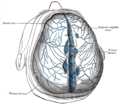Superior sagittal sinus
Superior Sagittal Sinus
The Superior Sagittal Sinus (SSS) is a dural venous sinus of the brain that runs along the top of the skull, from the front to the back. It is an essential component of the venous system of the brain, playing a critical role in draining deoxygenated blood and cerebrospinal fluid (CSF) back into the systemic circulation. The anatomy, physiology, and clinical significance of the superior sagittal sinus are complex and integral to understanding various medical conditions that can affect the brain.
Anatomy[edit]
The superior sagittal sinus is located within the upper border of the falx cerebri, a sickle-shaped fold of dura mater that descends vertically in the longitudinal fissure between the two cerebral hemispheres. It begins near the crista galli of the ethmoid bone and extends posteriorly to the occipital bone, where it ends by draining into the transverse sinuses. The SSS varies in size and shape along its course, typically being triangular in cross-section anteriorly and becoming more flattened and broader as it progresses posteriorly.
Physiology[edit]
The primary function of the superior sagittal sinus is to collect blood from the cerebral veins, as well as cerebrospinal fluid (CSF) from the arachnoid granulations, and transport it to the transverse sinuses. From there, the blood eventually makes its way to the internal jugular vein and returns to the heart. This process is crucial for maintaining intracranial pressure and ensuring the proper circulation of blood and CSF within the brain.
Clinical Significance[edit]
Several medical conditions can affect the superior sagittal sinus, including thrombosis, meningitis, and traumatic brain injury (TBI).
- Thrombosis: Superior sagittal sinus thrombosis (SSST) is a rare but serious condition where a blood clot forms in the sinus, potentially leading to increased intracranial pressure, seizures, and other neurological deficits. It requires prompt diagnosis and treatment, typically with anticoagulants.
- Meningitis: Inflammation of the meninges, the protective membranes covering the brain and spinal cord, can spread to the superior sagittal sinus, affecting its ability to drain blood and CSF efficiently.
- Traumatic Brain Injury: Direct trauma to the skull can damage the superior sagittal sinus, leading to bleeding (hemorrhage) or the formation of blood clots, both of which can have serious neurological consequences.
Diagnosis and Treatment[edit]
Diagnosis of conditions affecting the superior sagittal sinus typically involves imaging techniques such as magnetic resonance imaging (MRI) or computed tomography (CT) scans, which can visualize the sinus and identify abnormalities. Treatment varies depending on the underlying condition but may include anticoagulation therapy for thrombosis, antibiotics for infections, or surgical intervention in cases of severe trauma.
Conclusion[edit]
The superior sagittal sinus plays a vital role in the venous drainage system of the brain. Understanding its anatomy and physiology is crucial for diagnosing and treating various neurological conditions that can impact this critical structure.
-
Superior sagittal sinus
-
Superior sagittal sinus
-
Superior sagittal sinus
-
Superior sagittal sinus
-
Superior sagittal sinus
-
Superior sagittal sinus
-
Superior sagittal sinus
-
Superior sagittal sinus
-
Superior sagittal sinus
-
Superior sagittal sinus
-
Superior sagittal sinus
Ad. Transform your life with W8MD's Budget GLP-1 injections from $75


W8MD offers a medical weight loss program to lose weight in Philadelphia. Our physician-supervised medical weight loss provides:
- Weight loss injections in NYC (generic and brand names):
- Zepbound / Mounjaro, Wegovy / Ozempic, Saxenda
- Most insurances accepted or discounted self-pay rates. We will obtain insurance prior authorizations if needed.
- Generic GLP1 weight loss injections from $75 for the starting dose.
- Also offer prescription weight loss medications including Phentermine, Qsymia, Diethylpropion, Contrave etc.
NYC weight loss doctor appointmentsNYC weight loss doctor appointments
Start your NYC weight loss journey today at our NYC medical weight loss and Philadelphia medical weight loss clinics.
- Call 718-946-5500 to lose weight in NYC or for medical weight loss in Philadelphia 215-676-2334.
- Tags:NYC medical weight loss, Philadelphia lose weight Zepbound NYC, Budget GLP1 weight loss injections, Wegovy Philadelphia, Wegovy NYC, Philadelphia medical weight loss, Brookly weight loss and Wegovy NYC
|
WikiMD's Wellness Encyclopedia |
| Let Food Be Thy Medicine Medicine Thy Food - Hippocrates |
Medical Disclaimer: WikiMD is not a substitute for professional medical advice. The information on WikiMD is provided as an information resource only, may be incorrect, outdated or misleading, and is not to be used or relied on for any diagnostic or treatment purposes. Please consult your health care provider before making any healthcare decisions or for guidance about a specific medical condition. WikiMD expressly disclaims responsibility, and shall have no liability, for any damages, loss, injury, or liability whatsoever suffered as a result of your reliance on the information contained in this site. By visiting this site you agree to the foregoing terms and conditions, which may from time to time be changed or supplemented by WikiMD. If you do not agree to the foregoing terms and conditions, you should not enter or use this site. See full disclaimer.
Credits:Most images are courtesy of Wikimedia commons, and templates, categories Wikipedia, licensed under CC BY SA or similar.
Translate this page: - East Asian
中文,
日本,
한국어,
South Asian
हिन्दी,
தமிழ்,
తెలుగు,
Urdu,
ಕನ್ನಡ,
Southeast Asian
Indonesian,
Vietnamese,
Thai,
မြန်မာဘာသာ,
বাংলা
European
español,
Deutsch,
français,
Greek,
português do Brasil,
polski,
română,
русский,
Nederlands,
norsk,
svenska,
suomi,
Italian
Middle Eastern & African
عربى,
Turkish,
Persian,
Hebrew,
Afrikaans,
isiZulu,
Kiswahili,
Other
Bulgarian,
Hungarian,
Czech,
Swedish,
മലയാളം,
मराठी,
ਪੰਜਾਬੀ,
ગુજરાતી,
Portuguese,
Ukrainian











